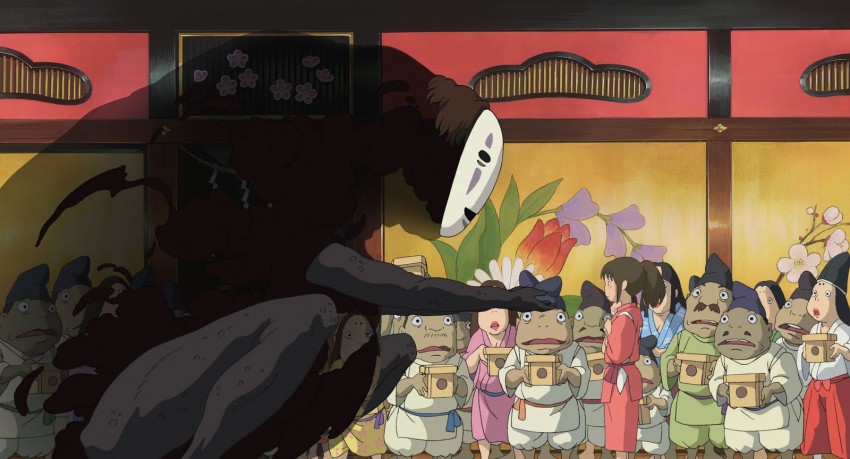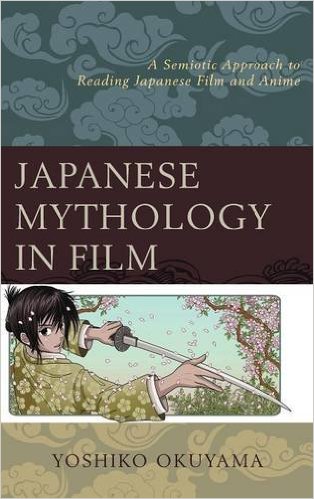Books: Japanese Mythology in Film
November 8, 2016 · 0 comments
By Jasper Sharp.
 It’s often reported how first-time visitors to Japan find themselves dumbfounded by the cacophony of new colours, sounds and symbols that greet them. What does the jumble of neon-lit hieroglyphs on that building mean? Why is that woman wearing traditional kimono on the metro? Why are there stone statues with little red bibs on the side of the road? Even many long-term foreign residents barely scratch the surface in comprehending what is really going on beneath the surface of the rich and labyrinthine empire of signs they are immersed in.
It’s often reported how first-time visitors to Japan find themselves dumbfounded by the cacophony of new colours, sounds and symbols that greet them. What does the jumble of neon-lit hieroglyphs on that building mean? Why is that woman wearing traditional kimono on the metro? Why are there stone statues with little red bibs on the side of the road? Even many long-term foreign residents barely scratch the surface in comprehending what is really going on beneath the surface of the rich and labyrinthine empire of signs they are immersed in.
For those exploring the country from afar, books, films, anime and manga can provide the most immediate way of gaining a foothold in a superficially alien world of unfamiliar traditions, religious beliefs and shared backstories – and undoubtedly to many the appeal of Japanese culture lies within the challenge of decoding the significance of the images and symbols presented by these digest forms and palimpsests of a living breathing culture. But to what extent do we isolate or exaggerate certain aspects of what we are experiencing, while overlooking or downplaying the significance of others?
These are some of the questions Yoshiko Okuyama’s Japanese Mythology in Film: A Semiotic Approach to Reading Japanese Film and Anime seeks to address, by exploring the use of mythology in eight films set at various points in Japanese history. The titles under analysis include three anime – Princess Mononoke, Spirited Away and Ghost in the Shell 2: Innocence – while all of the live-action features are manga adaptations, including Mushi-shi (2006), directed by Katsuhiro Otomo, a name more associated with the anime world, and Dororo (2007), based on the manga series of the same name by Osamu Tezuka, with the sole exception of Yojiro Takita’s 2008 live-action film Departures… although that, too, was also adapted into a manga.
 Japanese Mythology in Film evolved from a course taught by Okuyama at the University of Hawaii, aimed at undergraduate students and those taking their first steps into Japanese culture, so mercifully the theorising never gets too impenetrable. The author does a wonderful job in reorienting the reader by drawing equally from the work of Japanese scholars in the citations, much of which has not been translated. We’re not just decoding or deconstructing Japanese cinema through the framework of Western scholarship, although for the section on Ghost in the Shell 2: Innocence, Okuyama does draw a little bit too heavily for comfort from two essays on the film by Dani Cavallaro, and often unnecessarily so. One doesn’t have to reference Cavallaro to state that the gynoids in Innocence were influenced by the sculptures of Hans Bellmer and Yotsuya Simon, as Oshii himself has said as much on numerous occasions, including the film’s own press notes. I began my own review of the film for Midnight Eye in 2004 by detailing how its Japanese premiere had been preceded by an exhibition at the Museum of Contemporary Art in Tokyo entitled ‘Dolls of Innocence’, for which an accompanying catalogue was published.
Japanese Mythology in Film evolved from a course taught by Okuyama at the University of Hawaii, aimed at undergraduate students and those taking their first steps into Japanese culture, so mercifully the theorising never gets too impenetrable. The author does a wonderful job in reorienting the reader by drawing equally from the work of Japanese scholars in the citations, much of which has not been translated. We’re not just decoding or deconstructing Japanese cinema through the framework of Western scholarship, although for the section on Ghost in the Shell 2: Innocence, Okuyama does draw a little bit too heavily for comfort from two essays on the film by Dani Cavallaro, and often unnecessarily so. One doesn’t have to reference Cavallaro to state that the gynoids in Innocence were influenced by the sculptures of Hans Bellmer and Yotsuya Simon, as Oshii himself has said as much on numerous occasions, including the film’s own press notes. I began my own review of the film for Midnight Eye in 2004 by detailing how its Japanese premiere had been preceded by an exhibition at the Museum of Contemporary Art in Tokyo entitled ‘Dolls of Innocence’, for which an accompanying catalogue was published.
This is somewhat symptomatic of Okuyama’s approach of drawing almost exclusively from academic scholarship on the films discussed, rather than original sources. Sometimes, however, it is as if she can’t see the wood for the trees, bizarrely overlooking Noel Burch’s To the Distant Observer: Form and Meaning in Japanese Cinema (1979), the first and as far as I’m aware only other book-length work to apply the theories of Saussure and Barthes to Japanese film (quite a significant typo seems to have slipped through here, in which Saussure is said to have developed semiotics in the 1990s, when in fact it was the 1890s).
Furthermore, there’s little attempt to engage more thoroughly with many of the sources check-listed. Innocence, we are informed, is “a perfect text to introduce unique theories by Minakata Kumagusu”, although these theories are never explained and he is never mentioned again.
The analyses of the individual films get off to a good start with the chapter on Yojiro Takita’s two Onmyoji films (2001 and 2003), based on the series of novels by Yumemakura Baku featuring a detective-magician investigating mysterious occurrences within the aristocracy of 10th century Japan. In it, Okuyama outlines the esoterica that dominated the Imperial court during the period and its roots in Chinese Taoism, explaining the meaning between the mythological signifiers of certain colours (the relevance of the sacred colours of white and red within Shinto), numbers (such as ‘8’) and sigils (the star-shaped pentagon), as well as its main character’s basis in the historical soothsayer Abe no Seimei. This kind of extra-textual information is vital to understanding what is going on in the film. The gynoid self-destruction scene with which Innocence opens too gains extra levels of richness when likened to the Bunraku pupper theatre technique known as tsuno-dashi (“showing-horns”), in which the heads of its stock of initially normal-looking demonic characters break open, stick out their tongues and sprout horns to reveal their true nature at key points in the plot.
The book is also helpful when pointing out how the nuances of the original dialogue in the texts under discussion are sometimes eclipsed in the subtitles or dubs of their foreign releases, and explains the etymology behind the less readily translatable character combinations used to describe key philosophical concepts or spiritual phenomena in those titles with their roots deepest in ancient folklore. The original Mushi-shi manga by Yuki Urushibara is laden with allusions to classical literature, such as The Tale of Genji, through the author’s use of pre-modern words that would make little sense to modern Japanese viewers if rendered as spoken dialogue, but whose meaning is quite clear when written on the printed page. Okuyama also goes on to explains how the bluntly direct title translation of Bugmaster used for the English-language release of the film does little to convey the animistic connotations of the word ‘mushi’ as rendered in its earlier written character, where it effectively signalled any collection of living things and was often combined with other kanji characters such as wings or scales to refer to such phenomena as swarms, flocks or shoals.
Elsewhere, some of the parts in the better-known films under discussion are interesting but come across as a bit thin. Does, for example, the fact that the tea-serving automaton in Innocence is based on self-operating toys owned by wealthy merchants in the Edo period, or that the film’s standout carnival scene is similar to a parade held every July/August in Yokohama’s Chinatown, really add to any meaningful insight as to the deployment of such elements within the film? We think of anime as a relatively new phenomenon, but the three such titles covered in this book were all released between 10 to 20 years ago, and in light of their critical standing across the world and the vast amount that has been written about all of them, such observations are like barnacles on the hulls of battleships, more descriptive than interpretative. Okuyama herself rather unhelpfully dodges the issue by noting on Miyazaki: “I am not here to interpret his messages, as some have tried to do.”
Japanese Mythology in Film is probably best viewed as presenting new approaches to analysis rather than strong analysis itself, and as such can be recommended for undergraduates or early career academics. In any case, the price of £47 (and that’s on the Kindle!) means it is unlikely that its ideas will gain much traction beyond those without access to a university library. It is a point that has been made here many times before – academic publishers are doing no favours to their authors or potential readers by charging so much, and I’m sure most writers of books of this nature are motivated less by financial compensation than by the desire to see their work read and more widely discussed, both inside and outside the university system
In The Name of the Rose (1980), the debut novel of Umberto Eco, the only semiotician to really become a household name, there is a scene where the young Benedictine novice is first introduced to the hermetic confines of the monastery library. When it is explained to him that all of the theological texts are interrelated re-translations or reinterpretations of earlier sources, he has a vision of shelves of books literally chattering amongst themselves. Academia is in danger of going down exactly this same route, with little chance of those outside its own interpretative community to either learn from or participate in the discourse.
Jasper Sharp is the author of The Historical Dictionary of Japanese Film. Japanese Mythology in Film is available from Lexington Books.
books, cinema, Departures, ghost in the shell, Japan, Jasper Sharp, manga, Mushi-shi, mythology, Princess Mononoke, Spirited Away

Leave a Reply